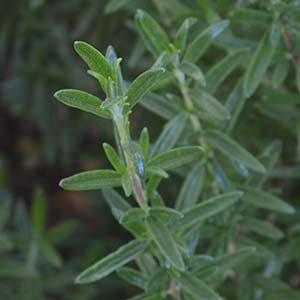
Another very useful herb plant, Rosemary plants are hardy to USDA zone 8, although they can be overwintered outdoors in zones 6 – 7 with some care.
Grown for the aromatic leaves, rosemary is used in a number of cuisines as well as for the extraction of essential oils.
Uses
This is a plant from Mediterranean areas and it has a log history with many uses including:
- Medicinal.
- Cosmetics.
- An ingredient for potpourri and of course as
- The ‘go to’ herb to accompany Lamb, Garlic and Tomatoes.
- Essential Oils.
- Rosemary is also used in landscaping, it lends itself to being clipped to form a low hedge.
It does have a strong pungent flavour, so for most home gardens one or two plants will do.
How to grow Rosemary
We suggest planting Rosemary in spring, this is the time when the soil is warming up and the plant will get a chance to form a good root system fairly quickly.
- Position – Full sun to a little afternoon shade
- Soil – Humus rich, loamy and well drained.
- Propagation – Easy from root cuttings.
- Overwintering – Rosemary plants will need to be overwintered in colder zones in a protected position. They do not cope well with freezes.
Planting Rosemary.
- Choose a sunny position, plant your mint and water in well.
- Keep the soil slightly moist for but well drained for best results.
- Prune back regularly to promote a bushy growth habit.
Propagation Methods.
- All Rosemary varieties are easily grown from cuttings taken in spring to summer
In colder zones, you can take cuttings each fall and grow them in pots over winter, indoors in a sunny position. They should be ready to plant out in spring to summer as the soil warms up.
General care
- Regular pruning will keep the Rosemary plant bushy and healthy. Try not to cut back into very old wood unless essential.
- Fertilise and water as needed, remembering that these plants do like a soil a little on the dry side.
Rosemary Varieties
A number of rosemary varieties are available, all with different growth habits.
- Rosemary officinalis – This is the variety most commonly used for culinary purposes.
- Rosemary officinalis ‘Tuscan Blue’ – More upright and taller growing.
- And around 45 other varieties.
Rosemary plants are readily available to buy from nurseries, garden centres and mail order suppliers.

